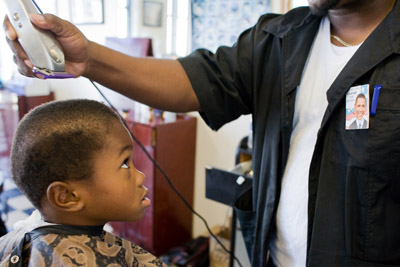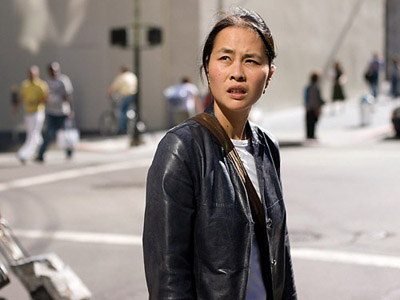Michael David Murphy, 100%. A single frame of film from 01/18/2009 in Washington, DC. Audio from Bloom. © MDM.
As part of my quest to learn more about the Atlanta art scene, I’ve been speaking with artists in the area—both seasoned inhabitants and newcomers alike. Since his arrival here two years ago from San Francisco, photographer Michael David Murphy has been busy pursuing his work while acting as the Program Manager for the annual six-week-long festival, Atlanta Celebrates Photography. Along with experimenting with digital and analog methodologies, Murphy has turned to text in his series, Unphotographable. With interests in social activism, photojournalism, and street photography, Murphy was especially affected by Road to Freedom, curated by Julian Cox, who we’ll be hearing from next.

Micheal David Murphy, "Barbers for Change," 2008. Courtesy MDM.
Victoria Lichtendorf: Can you tell me a little bit about yourself, how you ended up here in Atlanta, and your involvement with Atlanta Celebrates Photography (ACP)?
Michael David Murphy: I came to photography through poetry. I have an MFA in English, and while pursuing that, picked up a digital camera and fell (back) into photography.
I didn’t know any photographers, so I learned as much I could from libraries, wrote about my process of learning, and spent my time pursuing pictures, mainly on the streets of San Francisco. I ditched digital and moved to film cameras, which offer a special kind of something that’s hard to define, but feels essential.
I’ve been trying to extend ACP’s reach both locally and internationally with our web presence and festival programming…It’s our 11th year, and we’re excited to be bringing Gregory Crewdson and Harry Shearer to our Lecture Series this fall, in addition to all the other events; portfolio reviews, public art, exhibitions, a film series, and more. ACP’s goal is for Atlanta to become a city that’s known for its photography, and it’s an honest challenge to meet and address every day.
As someone new to the South, it was remarkable to move here and discover ACP and the festival. I felt as culturally plugged-in as I could be, while still a stranger in a pretty strange land. One of my goals at ACP is to provide as much support as we can to the diversity of photographers who are here in the metro area, but also provide something significant to people who’ve just moved here and are looking to hit the ground running.

Michael David Murphy, "R.I.P. U.S.A.," 2009. Courtesy MDM.
VL: As an active observer and an activist, how would you describe Atlanta to someone who has never visited? What makes you stay?
MDM: Atlanta’s surface is high gloss, but it’s deceiving. Beneath the new sheen, there’s a reality for artists that includes the possibility of affordable studio space, or the chance to convince a building that you want to install light boxes of ice photographs on their loading dock (my friend Denise Lira did this!)
It’s a blank slate in many ways, a kind of wild west. Burglars on bicycles rob banks here.
Atlanta’s the kind of place where there’s more cooperation than competition and the majority of “culture workers” here are doing their darnedest to make a meaningful impact in the city, for the city and beyond. And there’s room for everyone.
I had two shows last fall at Opal Gallery, a small but active new space in a pedestrian part of town (the only pedestrian part of town). It’s a space where the audience is everyone: dog walkers, students, moms with their kids, guys dropping their shirts off at the cleaners. If you make work that’s politically charged, and eager to find the right audience, it’s a gift to be able to engage people “off the street” with what you’ve made, in addition to the art crowd. I loved going to Opal and being there to chat with people who had questions about the work. Every morning there were smudge-prints of faces on the gallery’s glass from people trying to look into the space, straining to see art.
VL: Much of your work over the past year focused on the election and subsequent inauguration. In the wake of the first one hundred days, how has your focus shifted and what have you been up to lately?
MDM: My head is completely out of politics and I’m in the midst of a new large project about professional cycling. It’s personal—before art, I was an athlete, and have had a relationship with bikes (and going fast on them) my whole life. I’m making new photographs, as well as rephotographing vintage cycling magazines, and creating videos and sculpture…Cycling magazines were a kind of encyclopedia for me growing up. They showed what the sky looked like in Italy, how people screamed in France.
I’ve always thought about photography in athletic terms. I’m not skilled at talking subjects into psychologically revealing portraits, but I’ll sprint across the street to catch a passing moment…For the viewer, there may be magic in the picture; for me, the magic is in being there. It’s an unfashionable view perhaps, to trust that the world around you can equal and surpass the imagination, but I embrace it.

Michael David Murphy, "No Flash Corner, 2007." Courtesy MDM.
VL: Philip-Lorca diCorcia plays with the canon of street photography, and I was reminded of his Times Square Heads (1999-2000) when looking at No Flash Corner. Can you tell us more about this series?
MDM: No Flash Corner was a street corner I photographed over the course of a year in San Francisco. Under the right conditions, the light there was incredible, full-strength from both directions at the same time. As a place, the corner was a kind of arena to me, like a soccer pitch. (I can still smell the leathery air wafting out of the Coach store on the corner.)
I knew the rules dictated by weather and time and the angle of the sun, and I’d show-up and watch and wait and try to find the good pictures. After shooting there for a year, I wrote-up the recipe of how I photographed there (sans diCorcia’s strobes or long lenses) and people have taken that script and are shooting similar locations all over the world. Last month I saw some incredible shots from a No Flash Corner in Buenos Aires.
To me, the street is still the best place to cut your teeth. I can’t shoot that way here in Atlanta, because this isn’t a pedestrian city, but the lessons I learned there bleed into everything I do.




Pingback: Art 21 Blog Interviews ACP’s Program Manager Michael David Murphy | ACP Now!
Pingback: Road to Freedom: Interview with Julian Cox | Art21 Blog